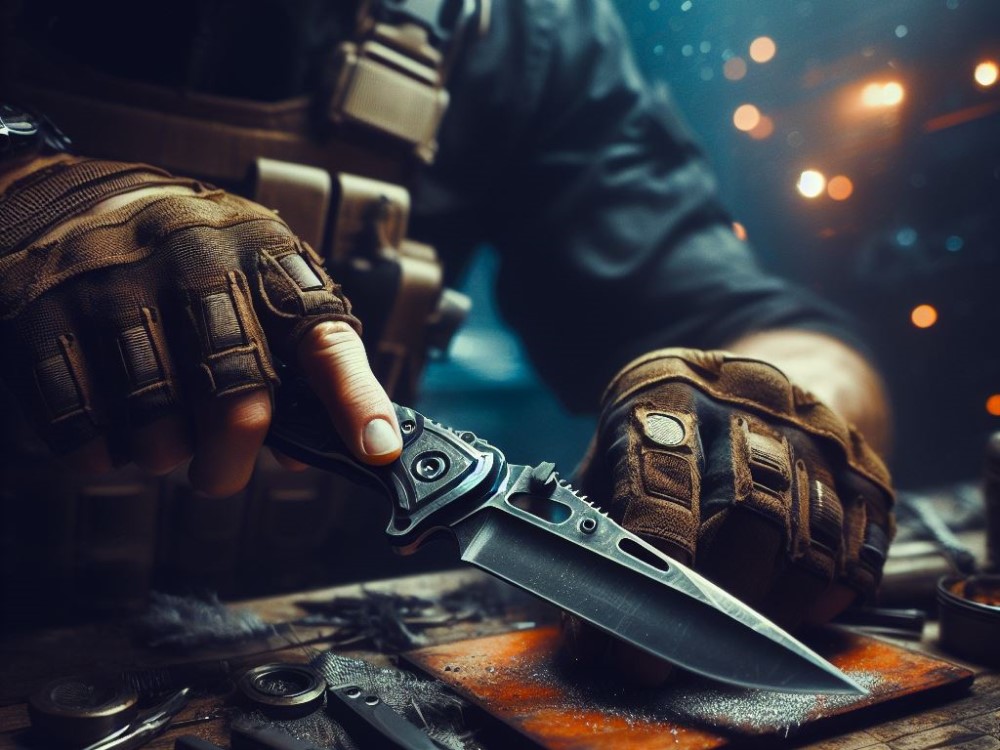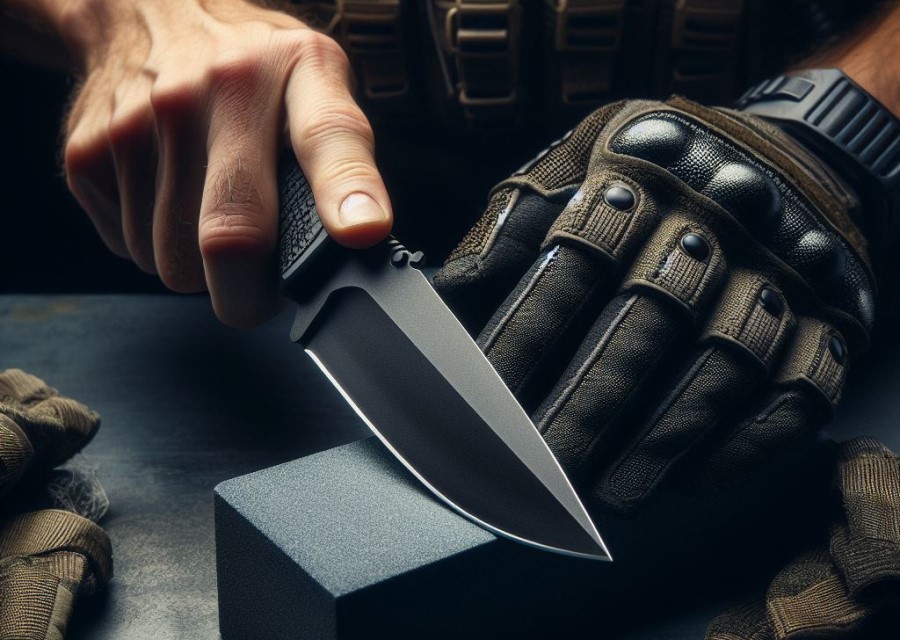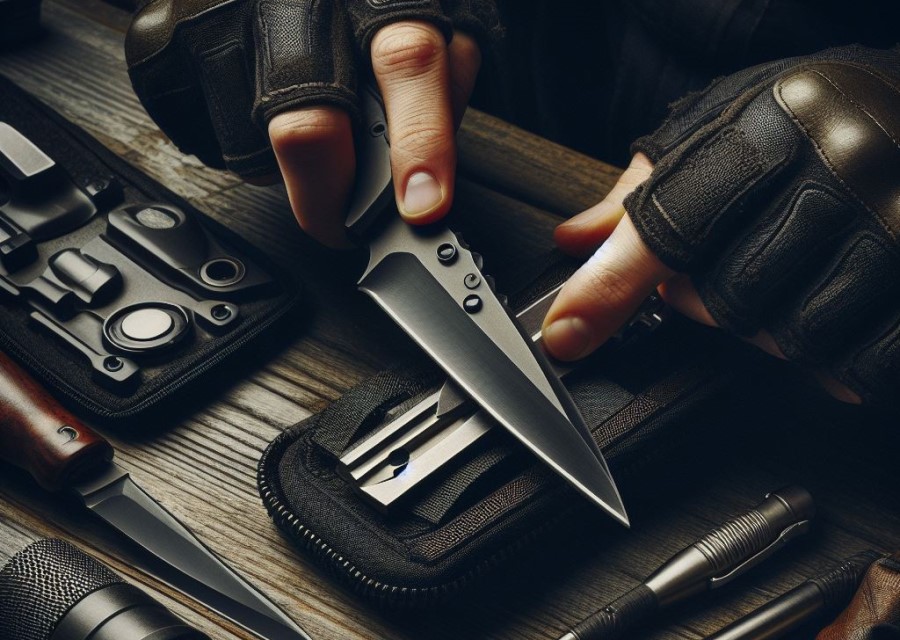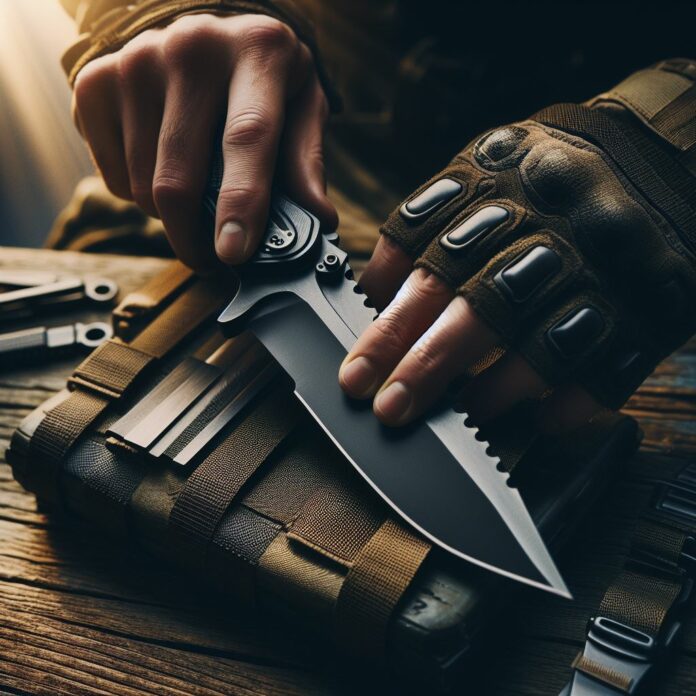Maintaining a tactical knife is crucial to ensure its optimal performance and longevity. Whether you rely on a tactical knife for self-defense, outdoor activities, or everyday tasks, keeping it in good condition is essential. Regular maintenance ensures that the knife functions properly when you need it the most and helps extend its lifespan.
There are several key reasons why understanding how to maintain a tactical knife is important. Firstly, a well-maintained knife ensures reliable and consistent performance, enhancing your safety and effectiveness in any situation.
Secondly, regular maintenance prevents rust, corrosion, and other forms of damage, preserving the knife’s structural integrity.
Proper maintenance helps retain the sharpness of the blade, ensuring precise and efficient cutting.
To keep your tactical knife in the best possible condition, preventive maintenance is essential. This includes regular cleaning of the blade to remove dirt, debris, and any potential contaminants.
The handle also requires attention to prevent wear, maintain grip, and ensure comfort during use.
Checking and maintaining the knife’s pivot, which is responsible for smooth blade opening and closing, is crucial for proper functionality.
Sharpening the blade is another important aspect of maintaining a tactical knife. There are various sharpening methods available, including using whetstones, honing rods, or sharpening systems.
Knowing the proper tools and techniques for sharpening helps keep the blade consistently sharp and ready for use.
Storing the tactical knife correctly is vital to avoid damage and ensure safety. Proper storage protects the knife from environmental factors such as moisture, extreme temperatures, and impact, which could lead to rust or blade damage.
Safe handling and transportation practices further safeguard the knife and prevent accidents or injuries.
Regularly checking and inspecting the knife for wear and tear is necessary to identify any issues or potential problems. This includes examining the blade, handle, locking mechanisms, and any additional components or features.
If any part of the knife is worn-out or damaged, timely replacement is crucial to maintain optimal performance and safety.
By following a comprehensive maintenance routine, you can ensure that your tactical knife is always in excellent condition, ready to serve you when needed. Whether it’s for personal defense or outdoor adventures, a well-maintained tactical knife is a reliable tool that you can depend on.
Importance of Maintaining a Tactical Knife

Maintaining the importance of a tactical knife is crucial to ensure its reliability and effectiveness. Regular maintenance is key to preventing corrosion and keeping the blade sharp, which allows for secure and precise cuts.
Proper cleaning and lubrication are essential in safeguarding the functionality and lifespan of the knife. Neglecting maintenance can result in decreased performance and potentially dangerous situations.
By implementing a disciplined maintenance routine, you can enhance the durability and functionality of your tactical knife, guaranteeing its readiness for use in critical situations.
Why is it important to keep a tactical knife in good condition?
It is important to keep a tactical knife in good condition for several reasons. Firstly, maintaining the knife ensures that it remains reliable and functional. By taking care of the knife, it will perform at its best, allowing for efficient and effective use in various situations.
Secondly, keeping the tactical knife in good condition extends its lifespan. Regular care and maintenance prevent wear and tear, corrosion, and other types of damage that could compromise the knife’s durability and overall duration of use.
In addition, a well-maintained tactical knife reduces the risk of accidents or injuries. By having a knife that is in good condition, with a sharp and stable blade, the chances of slipping or malfunctioning during use are reduced. This promotes safer handling and helps to avoid unnecessary harm.
Overall, it is crucial to keep a tactical knife in good condition to ensure its reliability, longevity, and safety during use.
Preventative Maintenance
To keep your tactical knife in optimal condition, preventative maintenance is key.
In this section, we’ll explore the essential steps you need to take to ensure its longevity and peak performance.
From regular cleaning and proper care to handle maintenance and pivot checks, we’ll cover all the bases.
So, whether you rely on your knife for outdoor adventures or tactical purposes, this section will equip you with the knowledge to maintain your blade like a pro.
Regular Cleaning of the Blade, Proper Care, Maintenance Tasks
Regular cleaning of the blade and proper care are crucial for maintaining a tactical knife in optimal condition. Here are some important maintenance tasks to follow:
- Regular Cleaning of the Blade: After each use, thoroughly clean the blade to remove any dirt, grime, or residue. Wipe away debris using a soft cloth or brush, ensuring all surfaces are clean.
- Avoiding moisture: To prevent rust or corrosion, keep the blade dry. If the knife gets wet, promptly dry it with a clean towel. Consider using a rust remover or rust-prevention spray to protect the blade.
- Lubricating the blade: Apply a light coat of lubricant to prevent friction and ensure smooth functioning of the blade. Make sure to use a lubricant that is safe for the specific type of steel used in your knife.
- Regular inspection for damage: Periodically check the blade for any signs of wear, chips, or nicks. If any damage is found, address it promptly by either repairing or replacing the blade.
- Proper storage: When the knife is not in use, store it in a dry and secure location. Consider using a sheath or knife roll to protect the blade from damage or exposure to moisture.
By regularly cleaning the blade, practicing proper care, and performing regular maintenance tasks, you can ensure that your tactical knife remains in excellent condition and is ready for use whenever needed.
Ensuring Proper Handle Maintenance
Ensuring proper handle maintenance is crucial for maintaining the optimal condition of your tactical knife. Here are some steps to follow:
- Regularly clean the handle using a mild soap or cleaning solvent to remove accumulated dirt, debris, and oils.
- Promptly inspect the handle for any signs of damage, such as cracks or loose screws, and address them immediately to prevent further harm.
- To prevent drying or cracking, moisturize the handle with a suitable oil or lubricant specifically designed for knife handles.
- Avoid exposing the handle to extreme temperatures or excessive moisture, as this can lead to warping or swelling.
- When not in use, store the knife in a secure and dry location. Consider using a protective sheath or case to prevent accidental damage or scratches.
- Regularly check the handle for any loosening or shifting of components, such as screws or liners. Take action to tighten or fix any issues and maintain stability.
- If your knife has a textured or grippy handle, periodically clean it with warm water and a soft brush to enhance grip and remove dirt.
Checking and Maintaining the Knife’s Pivot
Regularly checking and maintaining the knife’s pivot is crucial to ensure the proper function and longevity of a tactical knife.
- Inspect the pivot area for any debris or dirt that may have accumulated to ensure smooth operation. Use a brush or compressed air to remove any particles.
- Apply a small amount of lubricant, such as a lightweight oil, to the pivot area. This will help reduce friction and ensure the smooth opening and closing of the knife.
- Gently open and close the knife multiple times to distribute the lubricant and guarantee that it reaches all moving parts of the pivot.
- Regularly check for any looseness or excessive play in the pivot. If there is noticeable movement, tighten the pivot screw using the appropriate tool.
- If the pivot screw is stripped or damaged, it is advisable to replace it with a new one to maintain proper tension.
- Thoroughly examine the handle scales and liners for any signs of wear or damage. If necessary, tighten or replace any screws.
- If the pivot becomes stiff or difficult to move, it is recommended to disassemble the knife and clean the pivot area thoroughly. Check for any debris or built-up grime that may be causing the issue.
- After cleaning, remember to reapply lubricant to the pivot area before reassembling the knife.
By incorporating regular maintenance and inspections of the knife’s pivot, you can ensure smooth opening and closing, improve overall functionality, and extend the lifespan of your tactical knife.
Sharpening the Blade

Sharpening the Blade – Unveiling the secrets behind maintaining a sharp tactical knife. Discover the diverse world of sharpening methods and delve into the array of tools and techniques waiting to bring your blade back to its prime.
From honing to grinding, we’ll delve into the art of achieving that razor-sharp edge. Get ready to unlock the secrets of keeping your tactical knife at its best.
Types of Sharpening Methods
There are various types of sharpening methods that can be used to maintain a tactical knife:
1. Honing: Honing is one of the types of sharpening methods and is the process of realigning the edge of the blade. It can be done using a honing rod or a sharpening steel. This method does not remove significant amounts of metal from the blade.
2. Whetstone sharpening: Whetstone sharpening is another type of sharpening method which involves using a sharpening stone to grind and refine the blade. It is a traditional and effective method that can achieve a razor-sharp edge. Different grit levels of whetstones can be used to achieve different levels of sharpness.
3. Sharpening systems: Sharpening systems, such as guided sharpening systems, are also types of sharpening methods that provide a precise and consistent angle for sharpening the blade. These systems are recommended for beginners or those who prefer a guided approach to sharpening.
4. Electric sharpeners: Electric sharpeners are quick and convenient tools that use rotating stones or belts to sharpen the blade. They are another type of sharpening method and are suitable for maintaining a sharp edge, but may remove more metal from the blade compared to other methods.
5. Leather strop: A leather strop is used as the final step in sharpening to polish and refine the edge. It is an additional method that helps in removing any burrs or imperfections left after sharpening.
Tools and Techniques for Sharpening
Sharpening stone: A flat stone surface used to sharpen the blade by rubbing the knife against it at the correct angle.
Honing rod: A long, cylindrical rod used to straighten and refine the blade’s edge. It does not remove much metal but keeps the blade sharp.
Electric knife sharpener: A motorized device with rotating abrasive wheels or belts that quickly sharpen the blade when guided through the slots.
Whetstone: A type of sharpening stone specifically designed for knives. It provides a coarse and fine grit surface for sharpening.
Stropping: A technique that involves using a leather or fabric strip coated with polishing compound to polish and refine the knife’s edge.
Storing the Tactical Knife
Properly storing your tactical knife is essential to maintain its quality and prolong its lifespan. In this section, we’ll explore the best practices for storing your knife, including tips to avoid damage and ensure safe handling during transportation.
Whether you’re a collector or a frequent user, understanding the importance of proper storage will help preserve your knife’s sharpness, functionality, and overall performance.
Get ready to learn practical strategies that will keep your tactical knife in top-notch condition.
Proper Storage to Avoid Damage
Proper storage is essential to avoid damage to your tactical knife. Follow these steps to ensure your knife remains in optimal condition:
- Store your knife in a dry environment to prevent rust and corrosion.
- Keep your knife in a sheath or blade guard to protect it from accidental bumps or scratches.
- Avoid storing your knife with other sharp objects that could potentially damage the blade.
- Store your knife in a cool and well-ventilated area to prevent heat damage.
- Regularly inspect your storage area for any signs of moisture or humidity that could be harmful to the knife.
- If storing your knife for an extended period, apply a thin coat of rust remover or lubricant to the blade to provide additional protection.
Remember, proper storage practices can significantly extend the lifespan of your tactical knife and ensure it is always ready for use.
Fact: Storing your knife properly not only prevents damage but also helps maintain its sharpness and overall performance.
Safe Handling and Transportation
When it comes to safe handling and transportation, it is crucial to prioritize the tactical knife’s safety to avoid accidents and ensure its longevity.
- In order to prevent accidental cuts or injuries, always store the knife securely in a sheath or blade cover.
- When handling the knife, make sure to hold it firmly and securely to prevent any slipping or falling accidents.
- It is important to avoid swinging or waving the knife around as this can be dangerous and increase the risk of injury.
- During transportation, take the necessary precautions and ensure that the knife is properly packed to prevent any damage to the blade or handle. Consider using a padded case or wrapping the knife in protective material.
- When carrying the knife in public, it is crucial to follow the legal requirements and regulations of your area. If needed, discreetly conceal the knife and handle it cautiously.
- Never hand the knife to someone by grabbing the blade. Always hand it over safely, handle first.
- When the knife is not in use, always keep it in a secure location to prevent unauthorized access or accidental injuries.
- Exercise caution when cleaning the knife and utilize appropriate cleaning solvents and rust removers to ensure the blade’s longevity.
- If the knife requires maintenance or repairs, handle it with care and follow the proper procedures. Seek professional assistance if necessary.
- Regularly inspect and maintain the knife to identify any signs of wear and tear. Promptly replace any worn-out or damaged parts to maintain the knife’s functionality and safety.
Checking and Replacing Parts

When it comes to maintaining a tactical knife, one crucial aspect is checking and replacing its parts. In this section, we’ll dive into the nitty-gritty of ensuring your knife is in optimal condition.
From inspecting the knife for any signs of wear and tear to knowing when and how to replace worn-out or damaged components, we’ll cover it all. So, let’s buckle up and explore the essential steps to keep your tactical knife in top shape for any situation.
Inspecting the Knife for Wear and Tear
When inspecting a tactical knife for wear and tear, it is important to thoroughly assess its condition to ensure optimal performance and safety.
- Check for blade damage: Examine the blade for any signs of chipping, nicks, or dullness. Pay close attention to the cutting edge and look for any irregularities.
- Inspect for corrosion: Check the blade, the tang, and the handle for any signs of rust or corrosion. Use a rust remover or a cleaning solvent to remove any rust and prevent further damage.
- Examine the handle: Inspect the handle for any cracks, loose screws, or damage. Ensure that the handle is securely attached to the tang, providing a solid grip.
- Test the locking mechanism: If the tactical knife has a locking mechanism, carefully test it to ensure it functions properly. Make sure it securely locks the blade in place when open and easily releases when intended.
- Check the pivot: Assess the pivot area where the blade rotates. Look for any signs of wear or looseness. If necessary, tighten the pivot or apply lubrication to enhance the knife’s functionality.
Regularly inspecting your tactical knife for wear and tear will help identify any issues that may compromise its performance and safety. Addressing these concerns promptly will maintain the knife’s effectiveness and durability.
Replacing Worn-out or Damaged Components
Replacing worn-out or damaged components in a tactical knife is crucial to ensure its optimal performance and safety. Here are the steps to follow:
- Inspect the knife for wear and tear. Examine the blade, handle, and any other components for signs of damage or excessive wear.
- Identify the worn-out or damaged components. Look for bent or broken blades, loose or cracked handles, and worn-out screws or fasteners.
- Obtain replacement parts. Contact the manufacturer or a reputable knife supply store to find the appropriate replacement components for your specific knife model.
- Remove the old components. Disassemble the knife carefully, removing the worn-out or damaged parts from the knife.
- Install the new components. Following the manufacturer’s instructions, attach the replacement blade, handle, screws, or any other necessary parts to the knife.
- Ensure proper assembly. Double-check that all components are securely and correctly attached to the knife to prevent any potential hazards or loss of functionality.
- Test the knife. Once you have replaced the worn-out or damaged components, test the knife’s functionality and ensure that it operates smoothly and safely.
- Maintain regular inspection. Continue to periodically inspect your tactical knife to identify and replace any other worn-out or damaged components.
Remember, maintaining a properly functioning tactical knife is crucial for your safety and the knife’s performance. Regularly replacing worn-out or damaged components will help keep your knife in top condition.
Frequently Asked Questions on How to Maintain a Tactical Knife
How do I clean a tactical knife?
To clean a tactical knife, start by rinsing it under warm water and using mild soap to remove any dirt or debris. Avoid using harsh detergents. For hard-to-reach areas, use a thick kitchen sponge and a Q-tip. Repeat the cleaning process until the knife is clean, but avoid soaking it. Thoroughly dry the knife after cleaning to prevent rust and maintain its future usability. Remember to exercise safety precautions to protect your fingers during the cleaning process.
How do I care for a tactical knife long-term?
If you want to ensure the longevity of your tactical knife, it is important to take proper care of it. Avoid storing the knife long-term in the sheath, as it can lead to rusting and pits on the blade. Instead, store the knife near the sheath in a stable, dry environment. Regularly clean the knife after every use, removing any food residue immediately to avoid attracting dirt and damaging the blade. Additionally, apply oil on the blade after washing to prevent rusting and maintain its quality. These maintenance practices will help keep your tactical knife in top-notch condition for years to come.
What is the best option for sharpening a tactical knife?
The best option for sharpening a tactical knife depends on the type of blade and your personal preference. Many people prefer using ceramic sharpeners or carbide blade sharpeners to maintain the sharpness of their knives. However, it is important to note that these sharpeners may not be suitable for serrated blades. It is best to use a sharpener specifically designed for knives and follow the manufacturer’s instructions. Regularly sharpening the blade, according to the frequency of use, will keep your tactical knife in its most effective state.
How do I remove rust from a tactical knife?
If your tactical knife develops rust, there are a few methods you can try to remove it. You can use white vinegar, baking soda, or a mixture of lemon juice and salt. Apply the chosen substance to the rusted area, let it sit for a few minutes, and then scrub gently with a sponge or toothbrush. Rinse the knife thoroughly and towel dry. Remember to ensure the blade is completely dry before storing or using it to prevent further rusting.
How should I store my tactical knife?
To store your tactical knife, it is recommended to use a sheath or case specifically designed for knives. Avoid storing it in the sheath for extended periods, as it can increase the risk of rust formation and blade damage. Instead, store the knife near the sheath in a safe place away from children’s reach. Keeping the knife in a stable, dry environment will help protect it from corrosion and maintain its pristine condition.
What are some key safety precautions when maintaining a tactical knife?
When maintaining a tactical knife, it is important to prioritize safety. Always cradle the blade properly and avoid putting too much pressure on it to prevent bending the metal. Use protective gear, such as gloves and goggles, to protect yourself from potential accidents. Additionally, be cautious when handling sharp or soiled knives to avoid any cuts or injuries. Following these safety precautions will help ensure a safe and successful maintenance cleaning process.

